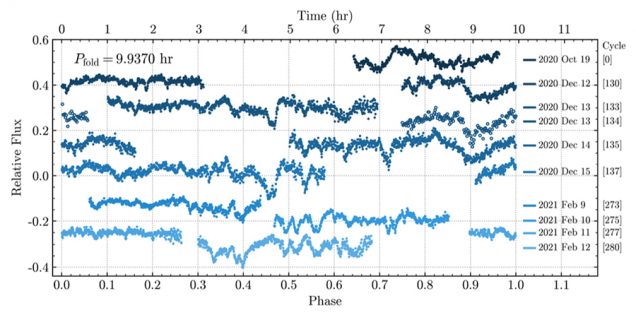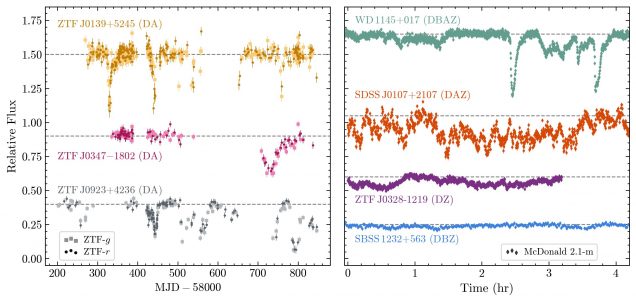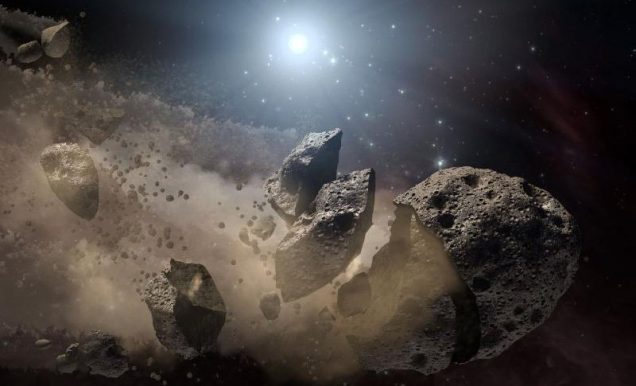The BU White Dwarf Group

Welcome to the home page of the BU White Dwarf group, headquartered a few blocks from Fenway Park in Boston, MA, USA.
Our research focuses on white dwarf stars and their connection to the endpoints of stars, binary, and planetary systems. Our work is supported by Boston University, the Institute for Astrophysical Research, the National Aeronautics and Space Administration (NASA), the National Science Foundation (NSF), and the Massachusetts Space Grant Consortium.
Recent news and group updates:
Research updates can be found below and on the news page.
Debris orbiting a white dwarf every 9.9 hours

In June 2021, collaborators from all over the world led by UT-Austin graduate student Zach Vanderbosch characterized the orbital period of transiting debris around a new white dwarf: ZTF J0328−1219. The debris shows repeating dips that are stable from night-to-night and repeat every 9.937 hr (shown in the figure above over several nights), as well as some other chunks that repeat every 11.2 hr. Spectra collected by BUWD group members were analyzed to show this is a strongly metal polluted white dwarf; new data show the debris shows circumstellar absorption features from the clouds of debris, as well. The work was accepted for publication and will appear soon in the Astrophysical Journal.
Untangling mysterious emission in some cool white dwarfs
In March 2021 work led by University College London graduate student Nik Walters was accepted to MNRAS analyzing GD 356, the prototype of a new class of just four white dwarfs that exhibit Balmer emission lines despite being apparently isolated stars. Here we provide strong evidence that this emission is not the result of a current generated by a close-in rocky planet; instead, this process may reveal a new phase of white dwarf evolution. This work includes multiple BUWD group researchers, as well as data collected remotely during the COVID-19 pandemic from BU's 1.8-meter Perkins Telescope Observatory, which helped rule out large spin-period changes in this rapidly rotating white dwarf.
More transiting debris found in ZTF

In December 2020 work led by UT-Austin undergraduate student Joseph Guidry and collaborators was posted to arXiv announcing up to five new white dwarfs showing transiting debris from the Zwicky Transient Facility (ZTF), more than tripling the number of such systems known! That work was accepted for publication in March 2021 and will appear soon in ApJ, and includes spectroscopy from the Lowell Discovery Telescope confirming that at least one of the white dwarfs with transiting debris is also heavily polluted by rocky debris. A thread can be found here on Twitter: https://twitter.com/jotajotahermes/status/1334144180231266312?s=20 as well as a thread on how we used Gaia's empirical uncertainties to select variable stars located here: https://twitter.com/jotajotahermes/status/1334509064596893701?s=20
Planetary debris transiting a second white dwarf

In July 2020, collaborators led by PhD student Zachary Vanderbosch at the University of Texas at Austin have published in The Astrophysical Journal only the second white dwarf known to show transits from an asteroid or planetesimal that got too close to its retired host star. The transits recur roughly every 100 days as the cloud of debris passes in front of the white dwarf. A thread first announcing the submitted paper is here, https://twitter.com/jotajotahermes/status/1166521382336913408, and the system continues to provide interesting surprises, including a deep new transit in November 2020: https://twitter.com/jotajotahermes/status/1326235133297520642
Seeing the interiors of massive A stars with TESS
Collaborators led by Tim Bedding at the University of Sydney published in Nature in May 2020 exciting new results from NASA's TESS mission that are some of the first convincing identifications of the oscillations of a class of massive A stars that pulsate, named after the prototype star delta Scuti. The 2-minute cadence of TESS has finally allowed astronomers to identify the pulsations in delta Scuti stars, especially those that are young. Besides a NASA press release and a Nature News & Views for more general audiences, a thread contextualizing the discovery is here: https://twitter.com/danxhuber/status/1260630021250494470